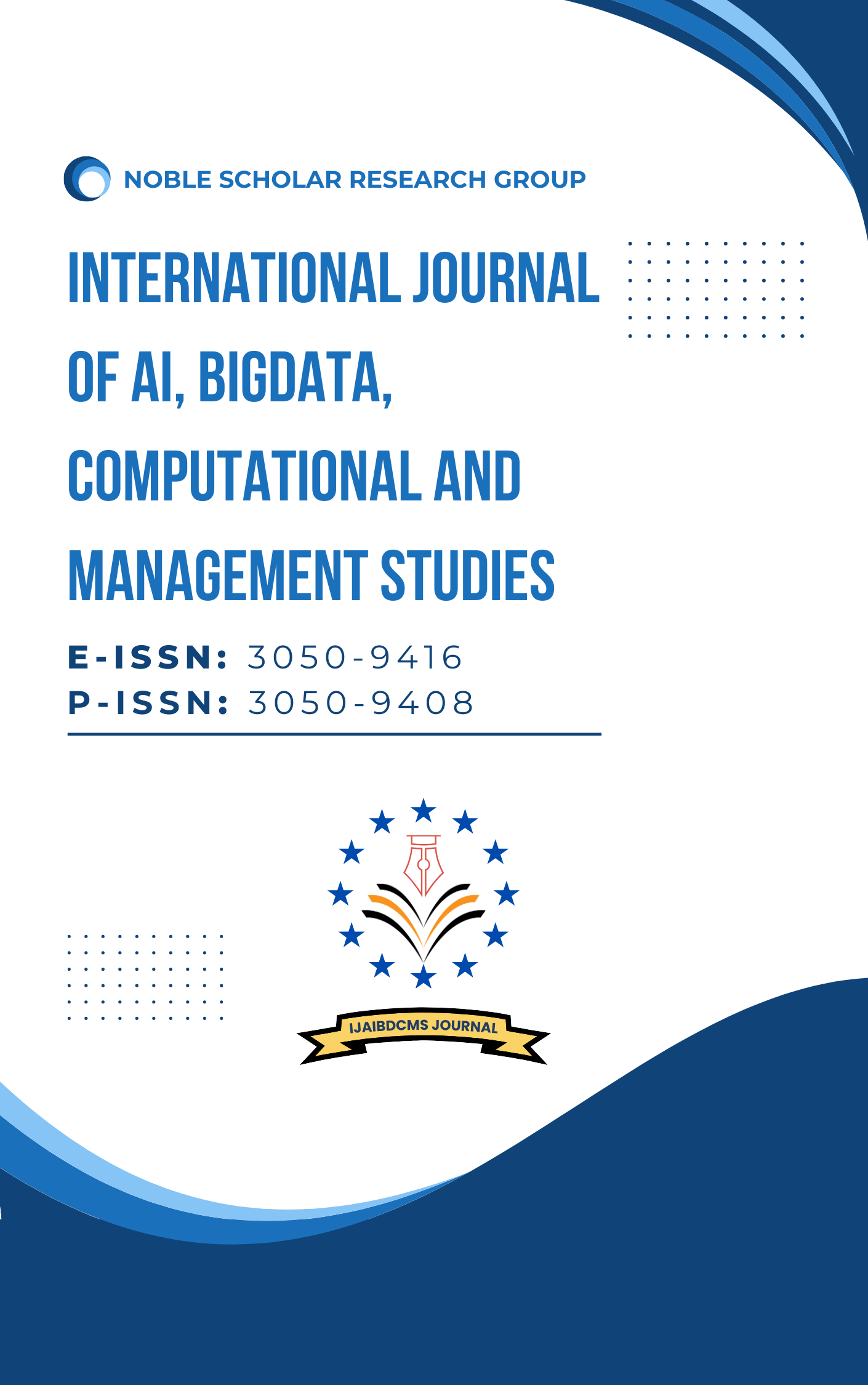Achieving Comprehensive Cyber Resilience: Integrating Compliance Frameworks and AI in Emerging Technologies
DOI:
https://doi.org/10.63282/3050-9416.IJAIBDCMS-V4I2P108Keywords:
Cyber Resilience, Compliance Frameworks, Artificial Intelligence (AI), Emerging Technologies, Cybersecurity RegulationsAbstract
The exponential growth of emerging technologies such as blockchain and quantum computing has revolutionized innovation but has also introduced unprecedented cybersecurity challenges. These technologies, while transformative, are increasingly targeted by sophisticated cyberattacks that exploit their unique vulnerabilities, such as smart contract flaws and quantum threats to cryptographic systems. To ensure the resilience of these innovations, integrating artificial intelligence (AI) with compliance frameworks offers a promising solution. AI-driven tools can enhance threat detection, automate compliance processes, and enable real-time monitoring, thereby fortifying cyber defenses. This paper examines the critical role of AI in augmenting compliance frameworks to address the cyber risks associated with blockchain and quantum computing. It further explores the synergy between AI and regulatory frameworks, proposing a conceptual model for achieving comprehensive cyber resilience. This integrated approach underscores the importance of adaptive strategies to safeguard future innovations
References
1. C. Cachin and M. Vukolić, "Blockchain Consensus Protocols in the Wild," arXiv preprint arXiv:1707.01873, 2017.
2. P. W. Shor, "Algorithms for Quantum Computation: Discrete Logarithms and Factoring," Proceedings of the 35th Annual Symposium on Foundations of Computer Science (FOCS), 1994, pp. 124–134.
3. R. Anderson, Security Engineering: A Guide to Building Dependable Distributed Systems, 2nd ed., Wiley, 2008.
4. M. Nielsen and I. Chuang, Quantum Computation and Quantum Information, Cambridge University Press, 2010.
5. H. Krawczyk, "Cryptographic Extraction and Key Derivation: The HKDF Scheme," Advances in Cryptology – CRYPTO 2010, Springer, 2010, pp. 631–648.
6. Sahai and B. Waters, "Fuzzy Identity-Based Encryption," Advances in Cryptology – EUROCRYPT 2005, Springer, 2005, pp. 457–473.
7. Mohri, A. Rostamizadeh, and A. Talwalkar, Foundations of Machine Learning, 2nd ed., MIT Press, 2018.
8. N. Z. Aitzhan and D. Svetinovic, "Security and Privacy in Decentralized Energy Trading through Multi-Signatures, Blockchain and Anonymous Messaging Streams," IEEE Transactions on Dependable and Secure Computing, vol. 15, no. 5, pp. 840–852, Sept. 2018.
9. G. Wood, "Ethereum: A Secure Decentralised Generalised Transaction Ledger," Ethereum Project Yellow Paper, 2014.
10. K. W. Parker, "Risk Management Strategies for Emerging Technologies," Journal of Cybersecurity Practice and Research, vol. 5, no. 2, pp. 45–63, 2017.
11. D. Boneh and M. Franklin, "Identity-Based Encryption from the Weil Pairing," SIAM Journal on Computing, vol. 32, no. 3, pp. 586–615, 2003.
12. L. Atzori, A. Iera, and G. Morabito, "The Internet of Things: A Survey," Computer Networks, vol. 54, no. 15, pp. 2787–2805, 2010.
13. National Institute of Standards and Technology, "Framework for Improving Critical Infrastructure Cybersecurity," NIST Special Publication 800-53 Rev. 5, 2017.
14. J. Voas, "Cybersecurity Standards: Managing Emerging Risks," IEEE Software, vol. 33, no. 1, pp. 82–85, Jan.-Feb. 2016.
15. S. Aaronson, "The Limits of Quantum Computers," Scientific American, vol. 298, no. 3, pp. 62–69, Mar. 2008.
16. H. Kim and M. Kang, "Machine Learning-Based Intrusion Detection Systems for Industrial Control Systems," Journal of Network and Computer Applications, vol. 103, pp. 44–58, Feb. 2018.
17. V. Chudnovsky, "AI-Based Predictive Risk Models for Cybersecurity," International Journal of Artificial Intelligence, vol. 6, no. 3, pp. 121–130, 2019.
18. Y. Bengio, I. J. Goodfellow, and A. Courville, Deep Learning, MIT Press, 2016.
19. N. Moustafa and J. Slay, "UNSW-NB15: A Comprehensive Dataset for Network Intrusion Detection Systems," Proceedings of the 2015 Military Communications and Information Systems Conference (MilCIS), Canberra, Australia, 2015, pp. 1–6.
20. H. Bhuyan, H. Bhattacharyya, and J. Kalita, "Network Anomaly Detection: Methods, Systems and Tools," IEEE Communications Surveys & Tutorials, vol. 16, no. 1, pp. 303–336, 2014.
21. M. C. Louie, "AI-Powered Risk Management in Supply Chain Cybersecurity," Journal of Cybersecurity Advances, vol. 8, no. 2, pp. 78–92, 2019.
22. S. Russell and P. Norvig, Artificial Intelligence: A Modern Approach, 3rd ed., Pearson, 2010.
23. D. J. Bernstein, J. Buchmann, and E. Dahmen, Post-Quantum Cryptography, Springer, 2009.
24. H. Kim, T. Shon, and Y. Kim, "A Study on Proactive Cybersecurity Risk Assessment Using AI Simulation Models," International Journal of Cybersecurity Research, vol. 12, no. 4, pp. 105–118, 2017.
25. Schneier, Applied Cryptography: Protocols, Algorithms, and Source Code in C, 2nd ed., Wiley, 1996.
26. R. Anderson, Security Engineering: A Guide to Building Dependable Distributed Systems, 2nd ed., Wiley, 2008.
27. K. Bonawitz et al., "Practical Secure Aggregation for Privacy-Preserving Machine Learning," Proceedings of the 2017 ACM SIGSAC Conference on Computer and Communications Security (CCS), pp. 1175–1191, 2017.
28. T. Campbell and L. M. Andre, "Cybersecurity Workforce Development: Addressing the Skills Gap," Journal of Cybersecurity Education, Research, and Practice, vol. 2, no. 1, pp. 12–20, 2016.
29. J. Frankle and M. Carbin, "The Lottery Ticket Hypothesis: Finding Sparse, Trainable Neural Networks," International Conference on Learning Representations (ICLR), 2019.
30. B. Schneier, "Toward Better Cybersecurity," IEEE Security & Privacy, vol. 17, no. 5, pp. 96–99, 2019.
31. Sahil Bucha, “Integrating Cloud-Based E-Commerce Logistics Platforms While Ensuring Data Privacy: A Technical Review,” Journal Of Critical Reviews, Vol 09, Issue 05 2022, Pages1256-1263. – 1
32. Aragani, V. M. (2022). “Unveiling the magic of AI and data analytics: Revolutionizing risk assessment and underwriting in the insurance industry”. International Journal of Advances in Engineering Research (IJAER), 24(VI), 1–13. - 1



